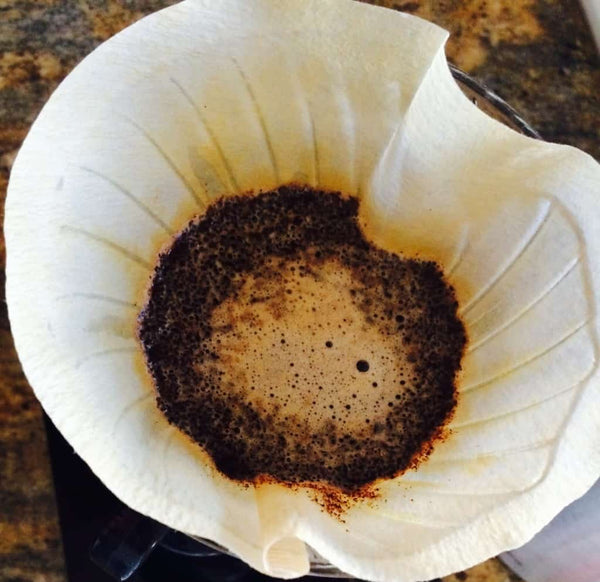
You keep hearing about it, but still don’t fully understand what coffee blooming is. We’re here to help clarify so next time that know-it-all-coffee-friend goes off on a blooming spiel, you can dethrone them as the know-it-all-coffee-friend.
What blooming is:
When coffee grounds come in contact with hot water, they release carbon dioxide and often bubble and expand. Coffee blooming is the act of dampening your coffee bed to provoke this release of carbon dioxide.

What causes it:
When coffee beans are roasted, the organic material of the bean is heated and releases carbon dioxide.
Beans will continue to release natural gases, or “degas”, gradually over 14 days (but most of the gas is released in the first 10). When you grind your coffee, or add hot water it speeds up the degassing process. (This is why you should always grind your coffee right before you brew).
Hot water in particular causes beans to immediately release most of their carbon dioxide. This creates a “bloom” when those first drops hit your coffee grinds.
Importance of the Coffee Bloom
Coffee drinkers who have never bloomed can miss out on some of the best flavors in their coffee, and also introduce some new, unwanted ones. When you first pour hot water over the coffee grounds, the release of carbon dioxide can push the water out of the way rather than allowing it to soak into the grounds, a process known as turbulence. This is in issue because it interferes with the water and coffee interaction, leading to under-extraction and preventing the coffee’s delicious natural flavors and textures from fully releasing into your cup.
Additionally, if you pour too much water at once, the carbon dioxide in the coffee may negatively affect the final flavor and lead to acidic or sour tasting coffee. Carbon dioxide does not taste good! Blooming your coffee first allows the carbon dioxide to release before you begin brewing and leads to a well-balanced, better extracted, and more flavorful cup.
How to bloom:
To bloom coffee, start pouring at center of your coffee bed, working your way out to the sides. Pour about two times the the amount of coffee you use. Wait 30 seconds for coffee to “bloom” and release CO2.
Grounds should be uniformly soaked, but not dripping wet. Here’s a handy video from Coffee Experimental for a visual aid:
Does All Coffee Bloom?
Blooming is most obvious with coffee that has been freshly ground and freshly roasted. If you don't see the bubbly foam that indicates your coffee is degassing, then you may be using old or stale coffee.
It's likely that you've watched a coffee bloom before without realizing what you were seeing. This is particularly so if you're a fan of espresso, as blooming is what causes the distinctive, flavorful foam to accumulate on the surface of your espresso shot.
Factors That Can Affect the Blooming Process
A coffee bloom is the degassing process, so anything that affects the rate of degassing can also affect the bloom. Degassing begins as soon as the coffee bean is roasted, so the longer you wait to use the coffee, the more likely it is that much of the degassing has already occurred.
Other factors that may affect the rate of degassing:
- Storage methods: Saving your coffee beans in an airtight container like our Atmos Vacuum Canister can keep them fresher for longer.
- Temperature: Higher temperatures can increase the rate of degassing
- Humidity: Lower humidity increases the rate of degassing, but too much humidity can allow mold or fungus to grow in the beans, so you need to find a middle ground
- Roast style: Darker roasts won't degas as much as beans that have been lightly roasted
Pour-Over Bloom
For pour-over coffee, blooming is an important step to creating a good tasting cup of coffee. You have control over the brewing process and can make sure that all the grounds are covered fully, allowing for a consistent rate of degassing and ensuring a balanced cup of coffee.
It's easy to determine whether your pour-over coffee is fresh. If you pour hot water over the grounds and it doesn't bubble, your coffee may be stale.
There are a few things you can do to ensure that your pour-over coffee blooms:
- Use freshly roasted coffee beans
- Grind your coffee just before you brew it
- Store your coffee in an airtight container, preferably in the freezer
French Press Bloom
You won’t see it mentioned in too many recipes, but you can also bloom your coffee when preparing French press! The process is similar to blooming a pour-over coffee. Just pour enough water to fully wet your coffee grounds and wait for 30-45 seconds before filling up the rest of the carafe and beginning the brewing process.
During the blooming process, you can stir the coffee grounds twice: once when you first pour the hot water over the coffee grinds and once after the coffee has bloomed to make sure the crust that collects on the top is mixed properly.
There is much debate on whether blooming is necessary in immersion brewing methods like French press, but we recommend experimenting and seeing if you can taste the difference!
What if you don't see a bloom?
This usually means your coffee has already degassed. This happens if your coffee is not fresh or your coffee bag wasn’t sealed correctly, and your beans oxidized. This could also be an indication your beans are over roasted. Blooming, like all other aspects of brewing coffee, takes experimentation with different roasts and techniques.
Ready to bloomin’ start?
Pick up some Pour-Over Essentials and a bag of freshly roasted coffee from our Coffee Collection and you’re all set to get a bloom.

































